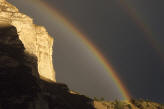|
|
|
|
|
 |
CULTURAL HISTORY
One of the first questions people ask when visiting
the rugged wilds of southern Utah is, "Who would live here?" The answer
is, "Many different cultures over thousands of years." A recent
archaeological survey of Bryce Canyon National Park and the Paunsaugunt
Plateau shows that people have been marveling at Bryce's hoodoos for at
least 10,000 years. |
|
|
|
|
|
It is suspected that throughout history, just as
today, most people were just passing through. Bryce Canyon winters are so
harsh that even modern year-round habitation is difficult. Yet
Paleoindians hunted huge mammals here at the end of the Ice Age. Pueblo
peoples hunted game in the forests and meadows of the plateau. Paiutes
frequented the plateau to harvest pine nuts and conduct broad scale rabbit
hunts called rabbit drives. Mormon pioneers diverted water from the
plateau top into the valley below by digging a 10-mile (16 km) long
irrigation ditch through the forests and rocky cliffs of what would later
become the park. Their efforts made the dry valleys below the cliffs of
Bryce suitable for agriculture, and gave them reason to name the town of
Tropic, Utah.
Later in 1924, designation as a national
park put Bryce Canyon on the map. But it was the Union Pacific Railroad
and the Civilian Conservation Corps that made Bryce accessible to modern
day travelers. Such improvements quickly made Bryce Canyon first a
national attraction, and later an international "must see." Today 1.5
million people come each year to see this little park with enormous
appeal.
|
|
|
Images and text courtesy of National Park Service. |
|

